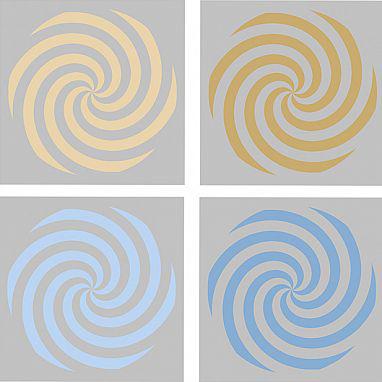Envision Color: Activity Patterns in the Brain Are Specific to the Color You See

Photo: Bevil Conway, NEI
Researchers at NEI have decoded brain maps of human color perception. The findings, published Nov. 17 in Current Biology, open a window into how color processing is organized in the brain, and how the brain recognizes and groups colors in the environment. The study may have implications for the development of machine-brain interfaces for visual prosthetics.
“This is one of the first studies to determine what color a person is seeing based on direct measurements of brain activity,” said Dr. Bevil Conway, chief of NEI’s unit on sensation, cognition and action, who led the study. “The approach lets us get at fundamental questions of how we perceive, categorize and understand color.”
The brain uses light signals detected by the retina’s cone photoreceptors as the building blocks for color perception. Three types of cone photoreceptors detect light over a range of wavelengths. The brain mixes and categorizes these signals to perceive color in a process that is not well understood.
To examine this process, Isabelle Rosenthal, Katherine Hermann and Shridhar Singh, post-baccalaureate fellows in Conway’s lab and co-first authors on the study, used magnetoencephalography or “MEG,” a 50-year-old technology that noninvasively records the tiny magnetic fields that accompany brain activity. The technique provides a direct measurement of brain cell activity using an array of sensors around the head. It reveals the millisecond-by-millisecond changes that happen in the brain to enable vision.
The researchers recorded patterns of activity as volunteers viewed specially designed color images and reported the colors they saw.
The researchers worked with pink, blue, green and orange hues so that they could activate the different classes of photoreceptors in similar ways. These colors were presented at two luminance levels—light and dark. The researchers used a spiral stimulus shape, which produces a strong brain response.
The researchers found that study participants had unique patterns of brain activity for each color. With enough data, the researchers could predict from MEG recordings what color a volunteer was looking at—essentially decoding the brain map of color processing, or “mind-reading.”
“The point of the exercise wasn’t merely to read the minds of volunteers,” Conway said. “People have been wondering about the organization of colors for thousands of years. The physical basis for color—the rainbow—is a continuous gradient of hues. But people don’t see it that way. They carve the rainbow into categories and arrange the colors as a wheel. We were interested in understanding how the brain makes this happen, how hue interacts with brightness, such as to turn yellow into brown.”
